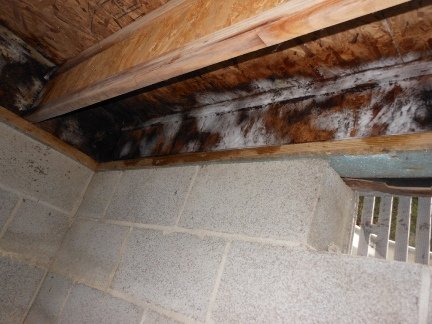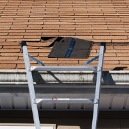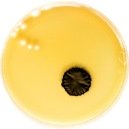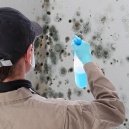Find a pre-screened local mold removal specialist Free Estimate
Find a Mold Specialist Now
Click or Call, Toll-Free 24/7
Crawlspace Mold
If your home was built on a crawlspace, one of your major concerns is the development of crawlspace mold. Crawlspaces rarely receive a lot of attention. They are dark, moist environments that we seldom enter with any regularity, However, with the addition of a little excess moisture, they can become a breeding ground for mold.
Usually the mold isn’t discovered until some type of repair is needed; a leaky drain line, an issue with heating ducts, or a home inspection when selling a home. Because certain molds can cause serious health complications, if mold is discovered in your crawlspace you need to start remediation efforts as soon as possible.
There are three classifications of molds depending on how they affect people. The first is allergenic molds. These are molds that aggravate people with allergies and are considered the least dangerous types, unless of course you are one of the people who are susceptible to them. The second type is pathogenic molds. These molds are toxic and will affect people with weakened immune systems, pregnant women, and young children. The last classification is toxigenic molds. These molds produce mycotoxins that will cause severe health problems. Exposure can be by touch, inhalation, or ingestion. An example of this class of mold would be the infamous Stachybotrys chartarum, also known as black mold.
Why Crawlspace Mold May Be Present
Crawlspaces can be ideal places for mold to flourish. Many times conditions in crawlspaces contain the right ingredients; a lack of UV light, warm temperatures, organic food sources like paper on insulation or wood, and most importantly, moisture in the form of water leaks, rainwater, or high humidity. All of these “ingredients”, plus the fact that crawlspaces are seldom entered, can lead to the existence of crawlspace mold.
Sometimes unwanted visitors or residents under your home can be the cause of crawlspace mold. Mice, rats, or other animals may decide that your crawlspace would make an excellent home. They tunnel or chew their way in, and in doing so, create an entry point for moisture to also enter the crawlspace. Sometimes the problem is high humidity. HVAC leaks, moisture condensation on ducts and water lines, or puddles of water from leaking drain lines or misdirected downspouts can add unwanted humidity to your crawlspace. Remember, moisture plus warm temperatures plus an organic food supply will equal a crawlspace mold problem.
One of the best ways to detect a mold problem is with the human nose. Almost all molds emit a musty, earthy smell. You may not be able to see it, but you may be able to smell it. If you do detect a musty smell, don’t ignore it. It won’t go away or get better as time passes, in fact the problem will just get worse.
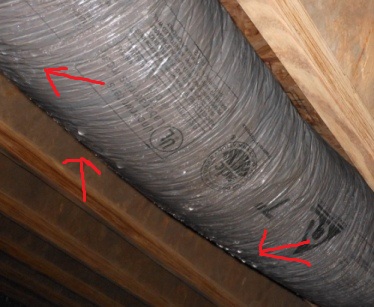 Moisture condensation on duct in crawlspace
Moisture condensation on duct in crawlspaceMold Is a Fungal Organism, Not Dirt or Dust
- You can’t eliminate mold with ordinary cleaning chemicals or detergents.
- You should not attempt to just sweep it or brush it away.
- Chlorine bleach, which is 98% water, should not be used to attempt to remove mold from porous surfaces like joists or plywood. The water in the bleach will further supply the mold’s needs for water.
- In biblical times people were not instructed to clean mold, they were told to remove it. Times haven’t changed; mold needs to be physically removed.
- What kind of mold is it? It doesn’t matter, you don’t want to keep it, get it removed.
Crawlspace Mold Removal
Once you discover mold in your crawlspace, how do you get rid of it? The first thing you must do when attempting to remediate mold anywhere is to protect yourself. You will need protective coveralls with a hood, covering for your shoes, goggles, gloves, and a N-95 rated respirator or dust mask.
Use a portable light source to assist in locating areas of contamination. Also spread a layer of plastic under affected areas to catch any mold that may be dislodged during the process (this plastic should then be gathered up, bagged and properly disposed of when your work is complete).
You should cover or seal any openings or vents in the ductwork that lead up into your home. This will prevent mold spores from dispersing into your above living spaces. It is recommended that a HEPA-rated (high efficiency particulate air) negative air machine be placed in the crawlspace before removal efforts begin. This machine is specifically designed to remove 99.97 percent of airborne particles from the air. It will protect the people working in the crawlspace as well as any residents in the home during the remediation. The HEPA air scrubber should be left running during the entire removal process and then for an additional 24-48 hours after the removal is complete. A fan or commercial air mover should also be used in the crawlspace for the last 24-48 hours to help “stir” the air and assist the air scrubber in collecting any mold spores that are remaining, floating around in the crawlspace as a result of being disturbed during the mold removal process.
There are several techniques for mold removal. One such technique is blasting. Soda and ice are the two most commonly used medias for blasting, but the DIY person would be advised NOT to attempt to use any blasting technique. The are several additional dangers to using this type of remediation in an enclosed space, especially if dry ice is used. Dry ice is frozen carbon dioxide. Instead of melting into a liquid, it returns directly into carbon dioxide gas. Adding carbon dioxide gas into a crawlspace, which is considered a confined space, can be extremely dangerous if you don’t have the proper training and safety equipment.
A safer method would be to spray a mold killer on all affected areas. Thoroughly saturate the mold then allow the product to dry. If necessary, reapply the chemical a second time if any visible mold remains.
Crawlspace mold removal is not a task to be taken lightly. Unless there is very little mold in a very small area, crawlspace mold removal should be left to professional mold remediators. We have a list of pre-screened mold removal specialists who will provide you with a free inspection of your home. These are contractors who work in your area and are licensed and trained in mold remediation.
Return From Crawlspace Mold To Our Main Remediation Page
Written by Mark Huey.
Free Home Inspection By A Mold Removal Specialist
Search This Website
Recent Articles
-
See Our 5 Recommended Mold Removal Companies in Covington, KY
Apr 16, 25 12:59 PM
-
See Our 5 Recommended Mold Removal Companies in Wheaton, IL
Jun 20, 24 10:33 AM
-
See Our 5 Recommended Mold Removal Companies in Aberdeen, SD
Oct 08, 21 04:05 PM
